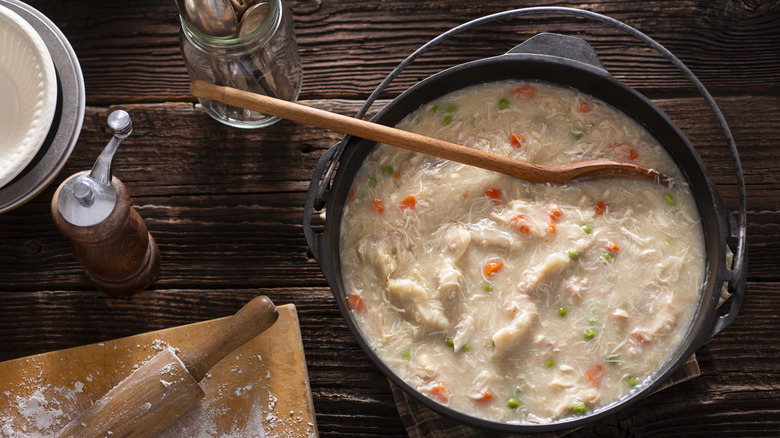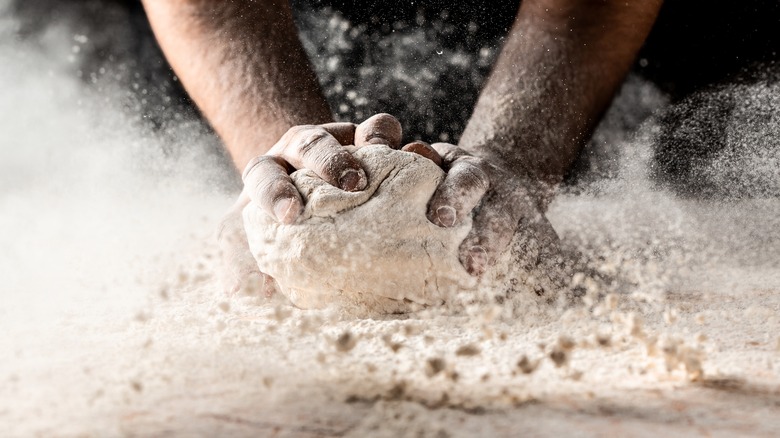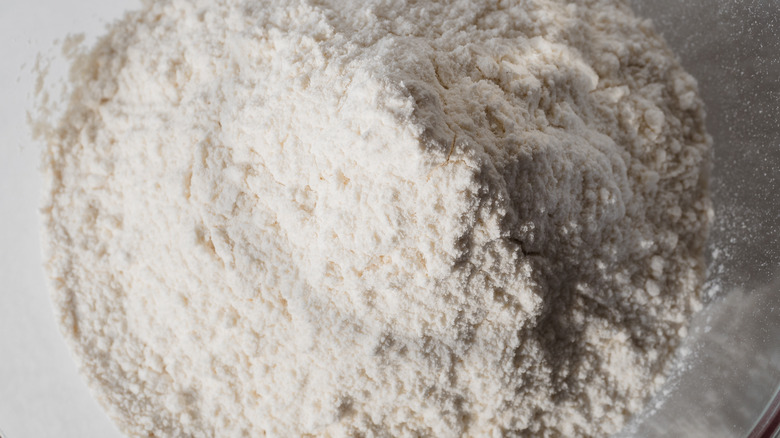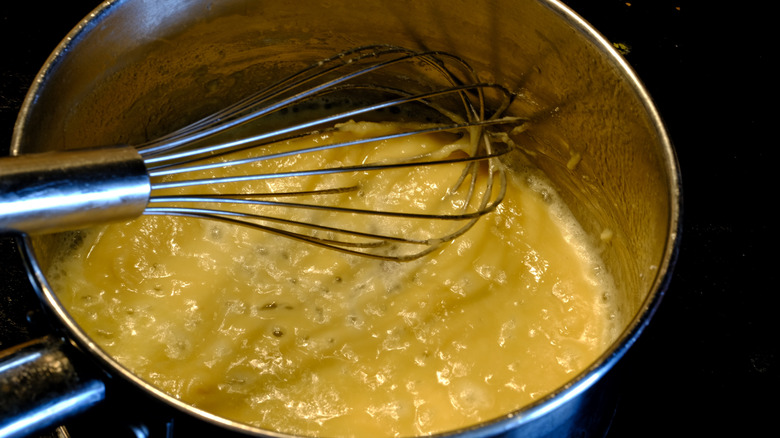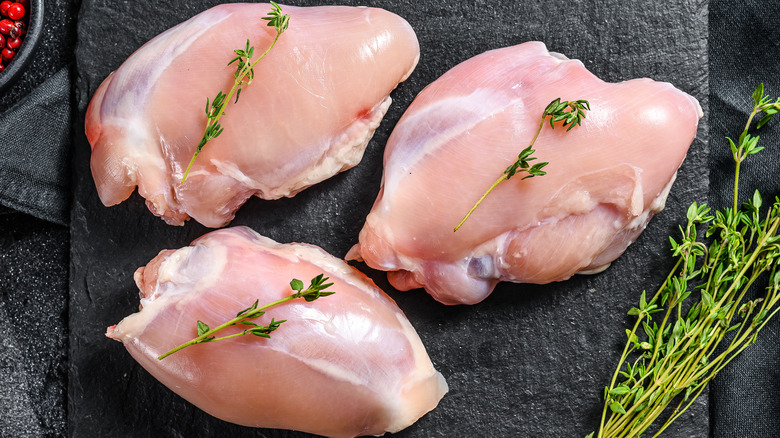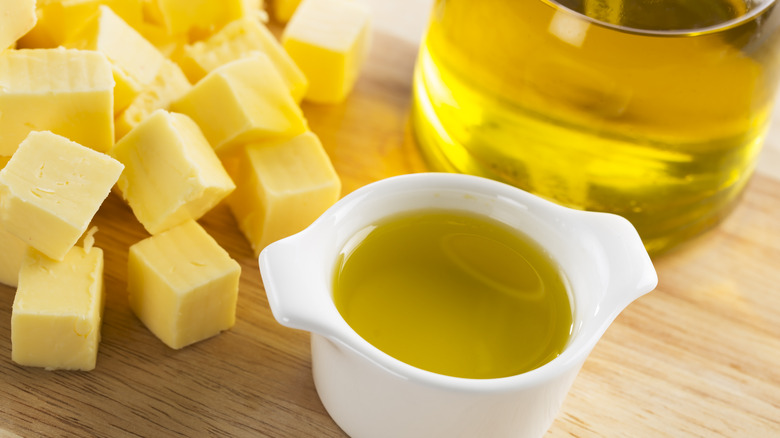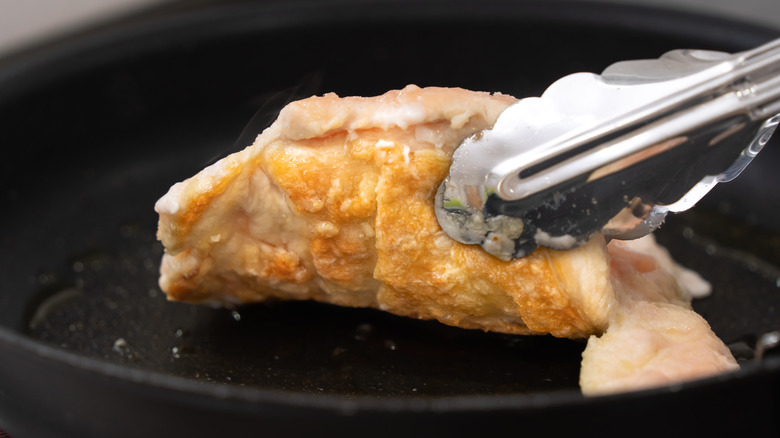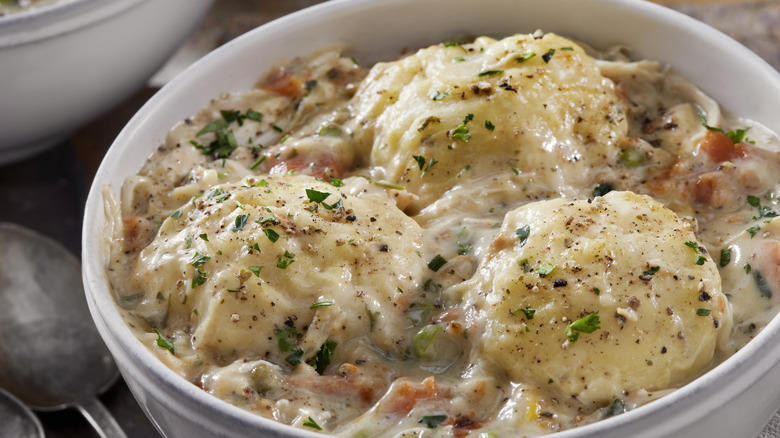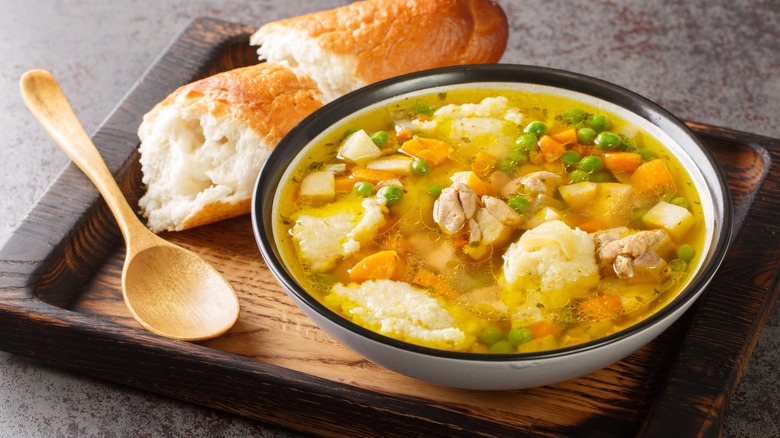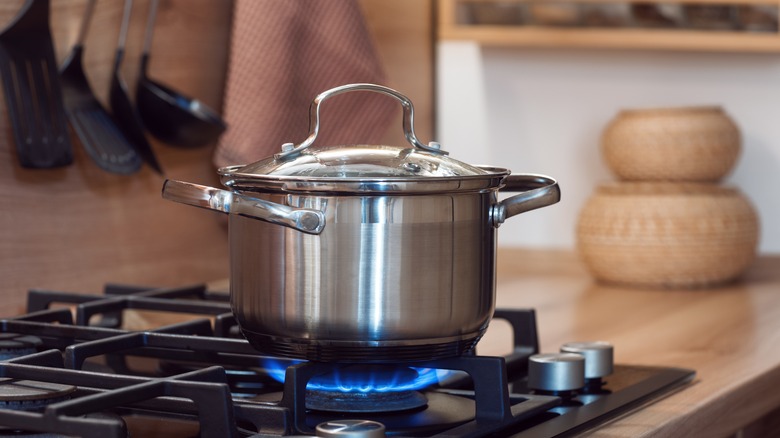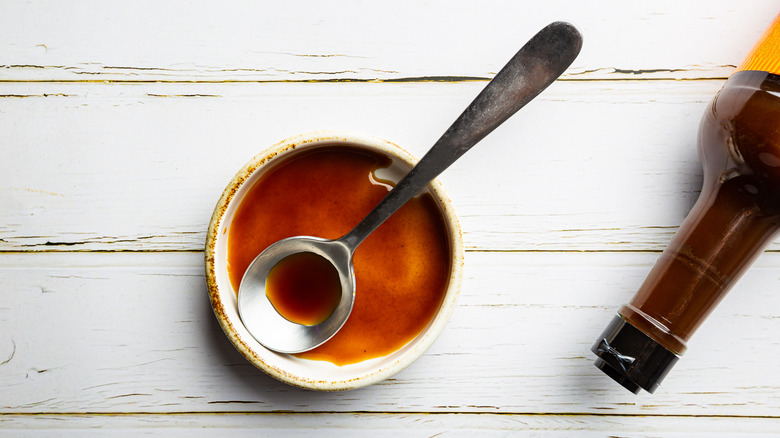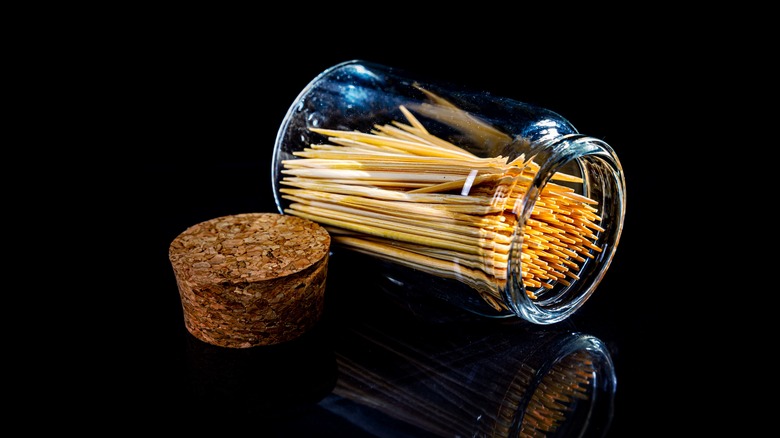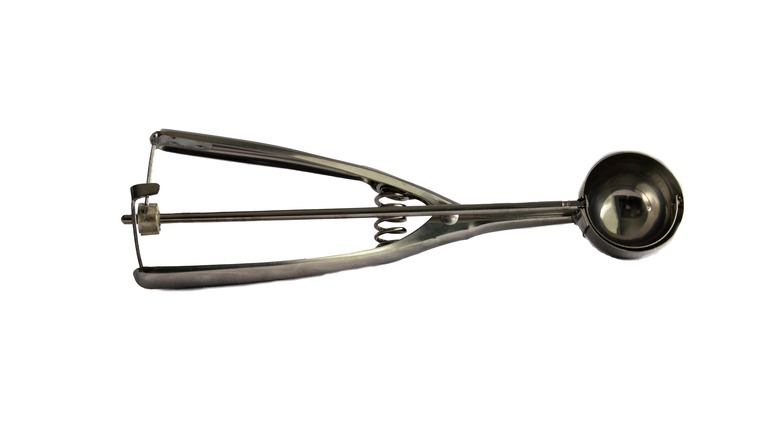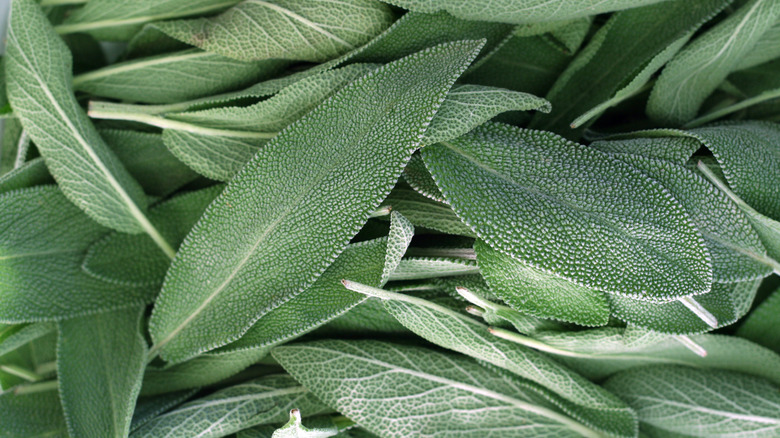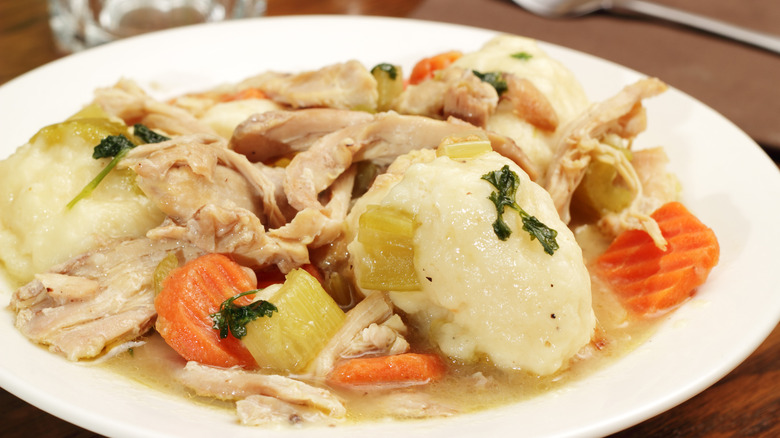14 Tips For Making Chicken And Dumplings That Will Make Your Grandma Proud
Of all the comfort foods in the world, few create a sense of coziness as well as chicken and dumplings. This homestyle dinner is one that's been cooked and served by caring parents and grandparents for hundreds of years. Recipes for dumplings began appearing in American cookbooks in the first half of the 19th century, and chicken started to show up in cooking directions shortly after that. In its most basic form, chicken and dumplings is a combination of cooked chicken breasts or thighs simmered together with flour-based, unfilled dumplings, in a flavorful broth made from stock, half-and-half, and/or cream.
Additional vegetables, like carrots, onion, and celery, are also routinely part of the recipe, giving it earthiness, body, and an added savoriness – and herbs and additional seasonings are also often added to brighten the flavor. All sounds pretty simple so far, right? Well, while chicken and dumplings may seem like a meal that anyone can make, the truth is that it's pretty difficult to get just right. Simple errors can lead to the dumplings becoming thick and stodgy, or the chicken lacking flavor, and too often the meal can end up curiously dry. Well, not anymore. With these top tips, you can make sure your chicken and dumplings are a meal for the ages.
1. Be gentle with your dough
The dumplings in chicken and dumplings are one of the two stars of the dish, so getting them right is vital. And it all starts with how you make your dough. While these dumplings are, when made right, chunky and satisfying, when they're made incorrectly by overworking the dough, they can toughen up fast. Overworking dough leads to an alteration and damage of its molecules, limiting its ability to stretch and remain fluffy when cooked. Instead, the dough tends to seize up and become inflexible and overly hard.
The solution is to be as gentle as possible when working with your dough. Stir together your dry and wet ingredients until just combined, and once your dough ball feels solid and well-formed, stop. Then you can start to divide them up to be cooked. If your recipe uses flat dumplings, or dumpling noodles that are cooked in the broth, make sure you don't roll them too thoroughly or re-roll the dough too many times, as this can toughen it up. Additionally, try not to add too much extra flour at this point to roll it out, as this can dry out the dough, making it dense.
2. Use the right kind of flour
Flour forms the bulk of your dumplings, so it's important to use the right kind. As well as trying to find quality flour from a reliable source, you should also make sure that the formulation is correct. Dumplings are almost always better made with self-rising flour, instead of regular plain flour. Self-rising flour has leavening agents like baking powder added to it, and this gives the items you make with it a lighter, spongier consistency. When the baking powder in self-rising flour mixes with liquids, a chemical reaction occurs in which it releases carbon dioxide, filling the dough with air bubbles that make it fluffier.
If you opt to use plain flour, on the other hand, this chemical reaction will not occur: Your dough will remain dense and bulky, and it will only get more so when you cook it. Luckily, if you don't have self-rising flour in the house, you can make your own in a pinch. Simply combine plain flour with baking powder and a touch of salt, aiming for a ratio of 1.5 teaspoons of baking powder for each cup of flour, with ¼ teaspoon of fine sea salt. Ensure that everything's mixed thoroughly before you add your wet ingredients.
3. Start with a roux
One of the most annoying things that can occur when making chicken and dumplings is a watery soup, that has no richness or creaminess to it. But this can be prevented by starting with a roux base for your liquids. A roux is a simple combination of plain flour and melted butter, which is cooked together before the liquid is added slowly. As the liquid comes up to heat, it combines with the flour, slowly turning into a thick, ultra-luxurious white sauce that serves as the base for your other ingredients.
A roux requires equal amounts of butter and flour to work best and ensure that the resulting sauce becomes thick enough without tasting too floury or chalky. To add it to chicken and dumplings, it's a good idea to cook all of your raw ingredients (your chicken and vegetables) beforehand, setting them aside after being sautéed. Then, make your roux in a clean pot, before adding your cooking liquids. Make sure to do this gradually, allowing the sauce to thicken each time, as it's very easy to add too much liquid and ruin it. Once your liquid is thick enough, add your ingredients back in, followed by your raw dumpling dough, and simmer everything until the dumplings are cooked.
4. If you can, avoid chicken breasts
Chicken breasts are widely used in chicken and dumplings, and for many, the idea of using another part of the chicken would ruin the dish. But the truth is that they're far from the best choice. Chicken breasts can become dry very quickly, due to the fact that they have very little fat to moisten them from the inside. While the creamy, thick soup that chicken and dumplings is held together by helps to prevent it being too chewy, if you're using large chunks of chicken it's unlikely to penetrate very deep into them.
The lack of fat also means that chicken breasts are less flavorful than other parts of the chicken. Rather than using chicken breasts, we recommend opting for chicken thighs. This cut has way more fat than the breast, and the meat is slightly darker and moister, giving your meal way more flavor. The fat content means that you can simmer chicken thighs for a good length of time (which you'll need for the dumplings to cook) without them drying out. If you do want to use chicken breasts, though, try to shred them down as much as possible, to ensure that they can be properly coated and moistened by the soup.
5. Combine your fats
The sautéeing process is a crucial step in making chicken and dumplings. By frying your chicken breasts and vegetables instead of just dumping them straight into the soup to cook, you develop a brown color on them and increase the overall flavor of the dish. But to do this, you need the right types of oil. Developing a good brown coating requires high levels of heat and butter, the traditional fat of choice, tends to break down at elevated temperatures. This causes it to smoke, giving your chicken and vegetables a nasty, burnt flavor.
To avoid this, cut your butter with some olive oil, or another vegetable oil with a high smoke point. By using half butter and half olive oil, you still get the creamy and indulgent flavor of butter, while preventing it from burning. If you wish, you can also skip the butter part entirely, using just olive oil — this is a good option if you're planning on getting a really good sear on your chicken and vegetables. If you do this, though, we'd recommend compensating with a little extra cream or half-and-half in your broth, to give it a little more body.
6. Fry your chicken instead of boiling it
Traditional chicken and dumplings are often made using boiled chicken breasts, which are then cubed up and dropped into the soup. Boiling the chicken breasts prevents you from having to use any additional oil to cook them, but it can also make the protein hard and almost inedible. If you boil chicken at a too-high heat, or keep it on the boil for too long, the proteins toughen up. This causes any moisture or fat in the meat to leach out, leaving you with tough chicken.
Rather than have this happen, you should aim to fry your chicken. Frying chicken and then leaving it to rest before cubing it up, allows the moisture to re-establish itself in the meat, giving you tender morsels. Frying the meat also develops flavor, thanks to the browning it gains on its exterior. It's also important not to boil your chicken once you've added it to the soup mixture, instead keeping it on a low simmer. This will not only stop the chicken from seizing up and getting tough but will also stop your dumplings from doing the same thing.
7. Add a thickener to your soup
You need a good amount of liquid to make chicken and dumplings, to ensure that everything remains moist and tender and that the dumplings can cook properly. But it's easy to overdo it. Adding too much stock, broth, or half-and-half to chicken and dumplings can make its liquid too thin, and you ideally want a soup that's thick, glossy, and creamy. It's not as simple as just simmering it for longer to reduce it, either: If you do that, both your chicken and your dumplings will become tough.
An easy fix, however, is to add a small amount of cornstarch slurry into the mixture a few minutes before serving. Mix a few tablespoons of cornstarch with water (as much as you wish, although we'd recommend an equal ratio of cornstarch to liquid so that you don't water the soup down). Pour it into the chicken and dumplings, mix it through, and simmer it gently until the soup thickens. If it's still too thin, you can add more in; If doing this makes it too thick, just cut the soup down with some more chicken stock. Cornstarch is basically tasteless, so won't alter the flavor of the meal, simply working to give it more body.
8. Don't simmer for too long
Chicken and dumplings are one of those meals that allows you to throw everything into a pot and forget about it until it's ready. But if you simmer it for too long, you may end up ruining your dumplings. Dumplings can overcook fairly easily, and when they do, they lose all their bite and fluffiness and start to fall apart. Your other ingredients can also suffer if you cook your mixture for too long, with the carrots, onions, and celery disintegrating and becoming mushy.
The easiest way to avoid this is to check how long your chicken and dumplings should cook carefully, and set a timer. Generally, chicken and dumplings recipes designate around 15 minutes of cooking time at a low simmer, once your dumpling mixture has been added to the soup. You may need a few minutes more than this if your dumplings are especially chunky. You should also try to avoid making your dumplings too small. If you do, they'll be more prone to breaking up in the pan, as the liquid and heat will penetrate them quicker.
9. Avoid checking on your dumplings
The sight of a gently bubbling pot of chicken and dumplings is pure comfort, but try to resist the temptation to check on it too much. The key to making perfect chicken and dumplings is to keep the lid firmly clamped on until your cooking time has elapsed. The dumplings cook from the steam released by the soup, and this makes them light and pillowy. Every time you open your pot, though, that steam escapes in one go, not only dropping the temperature of the mixture (and making it take longer to cook), but also causing your dumplings to become chewy instead of fluffy.
To ensure maximum steam coverage for your dumplings, make sure you're spreading them evenly around your pan, and that they're not touching. You should also try not to use too deep of a pot, or have a thin broth with no additional ingredients in them. This can cause the dumplings to sink into the soup too much and will result in them boiling instead of steaming. If the pot you wish to use doesn't have a lid, you can create a makeshift one by using a heavy baking sheet or an upturned frying pan.
10. Be bold with your flavors
Chicken and dumplings are a predictable dish — and that's a good thing. Its familiar savory flavors evoke a sense of comfort and nostalgia, which can be ruined if the dish is filled with unnecessary additions. However, that's not to say that you should be boring. A few choice ingredients, like Worcestershire sauce, mustard powder, and even hot sauce, can give chicken and dumplings a kick, and cut through the sometimes-stodgy nature of the dish.
Both hot sauce and mustard powder, when used moderately, bring a gentle heat to the meal. They can also add a tart edge which works well against the creamy soup and floury dumplings. If you don't have mustard powder, adding in a teaspoon of whole-grain or Dijon mustard can have the same effect. Using sour cream instead of half-and-half or heavy cream can also add tartness, without any of the spice.
Worcestershire sauce, meanwhile, amps up the savoriness of the meal, thanks to the umami-filled anchovy base. The molasses in the sauce also gives the dish a touch of sweetness, tempering the saltiness of chicken and dumplings (which can get pretty overpowering if you're using chicken stock). The key with all of these ingredients, however, is not to go wild. Add too much, and your chicken and dumplings will be altered beyond recognition, tasting overly powerful.
11. If in doubt, use a toothpick
Knowing when your dumplings are done is one of the hardest parts of making chicken and dumplings, and taking your pot off the heat too quickly can mean that they're not cooked through enough, and still raw dough on the inside. And while your dumplings floating to the surface can mean that they're ready, this isn't a universal science. An easy way to check your dumplings, though, is with a toothpick. Insert a toothpick into the middle of the thickest part of your dumpling. If it comes out without any raw dough on it, the dumplings are fully cooked.
Remember that you should only do this once your full cooking time is up, as checking them before this point can allow too much steam to escape, and your dumplings to cook irregularly. If you don't have any toothpicks to hand, try using a skewer. We would recommend not using a fork, however, because they have multiple prongs and will be more likely to just lift your dumpling straight out of the broth.
12. Make sure that your dumplings are evenly sized
One surefire way to ruin your chicken and dumplings recipe (and your guest's enjoyment of their meal) is to have irregularly sized dumplings. Failing to measure out your pieces of dough equally will leave you with some dumplings that are cooked before the others, meaning that you either have to serve some while still raw, or overcook your smaller ones. Additionally, your friends aren't exactly going to love it if one person gets a portion with large, fluffy dumplings, and another gets tiny, disintegrated ones.
So, make sure you measure your dumplings evenly, using a utensil to help you. The easiest way to do this is with a tablespoon or a cookie scoop. A #50 scoop works well here, as it's equivalent to 1.5 tablespoons, and will give your dumplings an even, rounded shape. Make sure that your utensil is well-greased, re-greasing it whenever necessary so that it doesn't stick to the dough. If you're using a tablespoon, try to get a nice, round shape with each dumpling, instead of leaving them too flat, as this can cause them to cook through too quickly.
13. Don't forget your herbs
Chicken and dumplings have a lot of fresh ingredients in them, but they can still end up tasting quite dense and flat. Luckily, adding herbs can prevent this from happening. Both dried and fresh herbs can give your chicken and dumplings a brightness, and add additional taste without requiring extra sodium. While any herbs you have to hand will help, parsley is the traditional choice and adds a slight pepperiness and grassy notes to the dish. Using fresh or dried sage, meanwhile, can give chicken and dumplings more earthiness, and boost its savory qualities, while fresh or dried rosemary can give it lemony, slightly pine-like undertones.
Whichever herbs you use, make sure to be careful with your ratios. Swapping out fresh herbs for dried ones will give you a more intense flavor, and require you to use about half the amount for the same effect. Dried herbs will also require a little more cooking to release their flavor, whereas fresh herbs tend to impart their taste quickly — but will lose potency the longer they're cooked. If using fresh herbs, add them right before serving, mixing them through the chicken and dumplings or using them as a garnish.
14. Add liquid when reheating it
Chicken and dumplings can be even better the day after you've cooked it. The longer that food sits after the cooking, the more its flavor and aroma molecules continue to develop, and these evolve even more when the dish is reheated. As well as this, allowing chicken and dumplings to sit gives the dumplings a chance to absorb more of the soup, giving them even more flavor and juiciness.
However, this absorption can be at the expense of the other ingredients. The more liquid the dumplings suck up, the less there will be for the chicken and vegetables, and this can leave the mixture quite dry. A top tip to moisten it back up is to pour a can of chicken broth into the chicken and dumplings before you reheat it. The chicken broth will add moisture and flavor simultaneously, whereas using just water will leave the dish flavorless. If you want added creaminess, you can mix some half-and-half in with the broth. Remember that your dumplings may absorb some of the broth as they heat back up, so don't be afraid to use a good amount of liquid – but if in doubt, reserve a little, and add more once it's warm.
